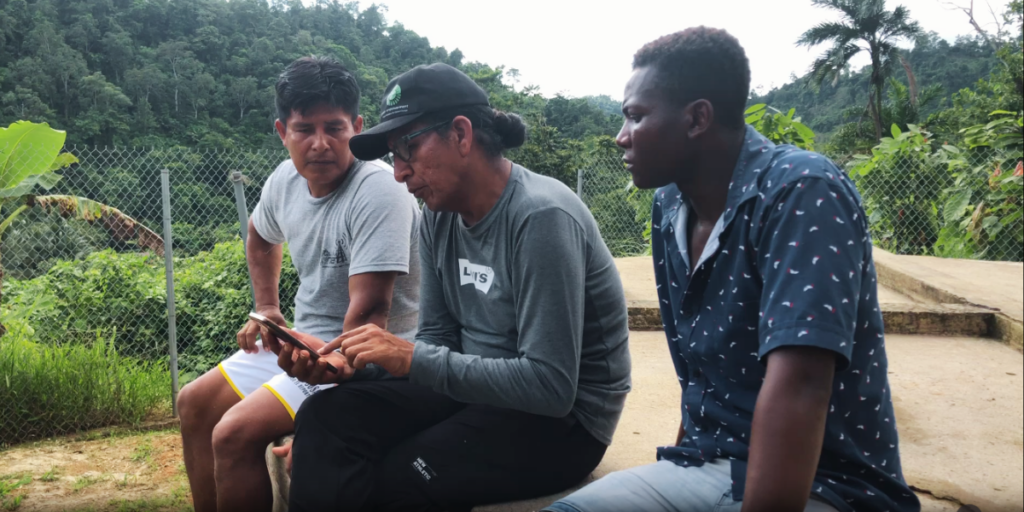By: Mica Miro, Engagement Manager, Green Empowerment
Is it realistic for a water committee of local citizens to manage a water system in perpetuity without outside support? What if the town grows considerably and needs a larger system? Or if there is an earthquake or a landslide? Should communities be able to weather these challenges on their own?
In June, I had the privilege of visiting communities and their water systems along the Cayapas River in Ecuador. Though I have been writing about the Río Cayapas for years, being there gave me a new understanding of why the water committees in this region are thriving.
Water Micro-Utilities: How they work
The cluster of vibrant Indigenous Chachi and Afro-Ecuadorian communities we were visiting was situated three hours by motorized canoe from the nearest roads, a remote location where many government services – including water utilities – simply do not reach.
Many of these neighboring communities have mobilized, working with Green Empowerment and our local partner ALTROPICO to build their own micro-utilities: piped water systems that deliver safe drinking water directly to people’s homes, schools, and businesses. The systems were built by community members themselves and they are managed by an elected committee of volunteers. All homes are equipped with meters so families can pay for their water usage each month (just like I pay my local utility here in Silverton, OR). Using these monthly fees, the water committee employs a trained technician from within the community, who performs routine maintenance, repairs leaks, and responds to issues. The combination of robust training for community members and a realistic and fair financial model are both key to long-term sustainability of the system.
But I knew all that before I visited – what I hadn’t thought about was the environment that these water committees are operating in.
Big Picture: Community Management in Context
In the Río Cayapas, ALTROPICO and Green Empowerment have worked with a series of communities within a fairly close geographic region (all within a one-hour boat ride of each other). Together, these communities make a network of water systems that are all built with similar equipment and engineering approaches and are all managed by local committees. With twelve systems now up and running, the communities have formed a WhatsApp (text) group where they can call on each other for support. We see several messages a week, asking for advice on a strange chlorine reading, or showing off their latest system improvements.

In addition to supporting each other, they can also seek help from our local partner. Since we continue to do projects together in the area, ALTROPICO staff are often present and available to community members. In just the three short days I was there, a couple of technicians from a neighboring town came by to find Gustavo. They sat with him for a while to get his technical advice on a system expansion that they are planning. Those local technicians are taking initiative and leading a new expansion – but they are not expected to do that in a vacuum, there is knowledgeable support to lean on.
We have also started to provide continuing education for system technicians. These training sessions bring together technicians from all twelve communities – allowing veteran technicians to sharpen their skills and new technicians to get up to speed.
And perhaps my favorite example of regional collaboration is the plumbing hardware store that we helped establish in Zapallo. This centrally located store is a collective enterprise between all twelve water committees, giving them all a local place to buy replacement parts. So if a system needs a repair, they can get a new part that day and not have to travel three hours by boat to the next largest town.

Our Responsibility
So yes, these water committees are fully managing their own systems, local technicians are maintaining the systems, and monthly fees are paying for upkeep. But we do not expect on-going success in a vacuum. When I talked with Green Empowerment Water and Sanitation Lead Sam Schlesinger about this, he said:
“Community management was never supposed to be sustainable, and was never supposed to be implemented, without a supportive environment.”
Depending on the local context, this supportive environment might be led by the local government, or it might be led by national networks or civil society actors. In the absence of these options, we need to continue to cultivate supportive environments through investing in intentional development within a close geographic region, active encouragement of networking between water systems, continuing education for water committee members, and collaboration with local partners who have a long-term commitment and presence in the region.
Want to support community-driven development? Make a donation today and know that you are investing in human-centered solutions with the support they need to thrive.

Mica is a creative professional with a background in program management and arts education. Previously, Mica served as Interim Managing Director and Responsible Tourism Manager for a small NGO that supports women entrepreneurs in Oaxaca, Mexico.

This is great writing on an important subject! Thank you. Brava!
Thanks so much for the comment Lee. Great to see that you are following the work – we were just writing donor postcards and thinking of you!